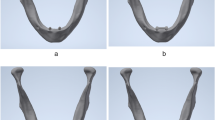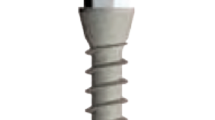Abstract
Purpose
Using three-dimensional finite element analysis, this study aimed to provide insight into the complexity of stresses and deformations induced by trauma on a mandible reconstructed with 5 different treatment plans of implant-supported overdentures and 3 different implant lengths.
Methods
A 3D model was generated from a Cone Beam Computed Tomography CBCT image of the edentulous mandible. A perpendicular force of 700 N was applied to the mandible in three different locations.
Results
Regardless of traumatic load location, peak maximum principal stress in the cortical and cancellous bone of the model – with an overdenture supported by 5 implants following an overdenture supported with 3 implants – was minimal. Of the 45 models, the highest maximum principal stress within the cortical bone was measured in an overdenture on 2 implants (510 MPa), and the lowest (55 MPa) was observed in an overdenture on 3 implants. An increase in the load from 700 N to 2000 N increased the maximum principal stress levels within the bone up to 127%.
Conclusions
The study revealed that stress and deformation distribution within a mandibular bone treated with dental implants were influenced by the treatment plan but not by implant length. Furthermore, the implant-bone interface was found to be the most fracture-prone site, followed by the condylar neck.











Similar content being viewed by others
Data Availability
The datasets generated during the current study are available from the corresponding author on reasonable request.
References
Chrcanovic, B. R. (2012). Factors influencing the incidence of maxillofacial fractures. Journal of Oral and Maxillofacial Surgery, 16(1), 3–17. https://doi.org/10.1007/s10006-011-0280-y
De Mello Santos, L. S., Rossi, A. C., Freire, A. R., Matoso, R. I., Caria, P. H. F., & Prado, F. B. (2015). Finite-element analysis of 3 situations of trauma in the human edentulous mandible. Journal of Oral and Maxillofacial Surgery, 73(4), 683–691. https://doi.org/10.1016/j.joms.2014.10.014
Lee, K. H. (2009). Interpersonal violence and facial fractures. Journal of Oral and Maxillofacial Surgery, 67(9), 1878–1883. https://doi.org/10.1016/j.joms.2009.04.117
Torreira, M. G., & Fernandez, J. R. (2004). A three-dimensional computer model of the human mandible in two simulated standard trauma situations. Journal of Cranio-Maxillofacial Surgery, 32(5), 303–307. https://doi.org/10.1016/j.jcms.2004.04.008
Vyas, A., Mazumdar, U., Khan, F., Mehra, M., Parihar, L., & Purohit, C. (2014). A study of mandibular fractures over a 5-year period of time: A retrospective study. Contemporary Clinical Dentistry, 5(4), 452. https://doi.org/10.4103/0976-237X.142808
Farhadi, F., Parvash, M., & Zarandi, A. (2016). Assessment of epidemiology in patients with maxillofacial trauma from a single hospital of Tabriz. Journal of Evolution of Medical and Dental Sciences, 5(44), 2742–2746. https://doi.org/10.14260/jemds/2016/640
Almasri, M., & El-Hakim, M. (2012). Fracture of the anterior segment of the atrophic mandible related to dental implants. International Journal of Oral and Maxillofacial Surgery, 41(5), 646–649. https://doi.org/10.1016/j.ijom.2012.01.004
Meijer, H. J., Raghoebar, G. M., & Visser, A. (2003). Mandibular fracture caused by peri-implant bone loss: Report of a case. Journal of Periodontology, 74(7), 1067–1070. https://doi.org/10.1902/jop.2003.74.7.1067
Oh, W. S., Roumanas, E. D., & Beumer, J., 3rd. (2010). Mandibular fracture in conjunction with bicortical penetration, using wide-diameter endosseous dental implants. Journal of Periodontology, 19(8), 625–629. https://doi.org/10.1111/j.1532-849X.2010.00646.x
Balaguer, J., Ata-Ali, J., Peñarrocha-Oltra, D., García, B., & Peñarrocha-Diago, M. (2015). Long-term survival rates of implants supporting overdentures. Journal of Oral Implantology, 41(2), 173–177. https://doi.org/10.1563/AAID-JOI-D-12-00178
Kan, B., Coskunses, F., Mutlu, I., Ugur, L., & Meral, D. (2015). Effects of inter-implant distance and implant length on the response to frontal traumatic force of two anterior implants in an atrophic mandible: Three-dimensional finite element analysis. International Journal of Oral and Maxillofacial Surgery, 44(7), 908–913. https://doi.org/10.1016/j.ijom.2015.03.002
Topkaya, T., Solmaz, M. Y., Dündar, S., & Eltas, A. (2013). Numerical analysis of the effect of implant geometry to stress distributions of dental implant system. Cumhuriyet Dental Journal, 18(1), 17–24. https://doi.org/10.7126/cdj.58140.5000037693
Bahat, O. (2000). Brånemark system implants in the posterior maxilla: Clinical study of 660 implants followed for 5 to 12 years. International Journal of Oral & Maxillofacial Implants, 15(5), 646–653.
Ferreira, M. B., Barão, V. A., Delben, J. A., Faverani, L. P., Hipólito, A. C., & Assunção, W. G. (2014). Non-linear 3D finite element analysis of full-arch implant-supported fixed dentures. Materials Science and Engineering C, 38, 306–314. https://doi.org/10.1016/j.msec.2014.02.021
Sánchez-Pérez, A., Moya-Villaescusa, M. J., Jornet-García, A., & Gomez, S. (2010). Etiology, risk factors and management of implant fractures. Medicina Oral, Patologia Oral y Cirugia Bucal, 15(3), e504–e508. https://doi.org/10.4317/medoral.15.e504
Baggi, L., Cappelloni, I., Di Girolamo, M., Maceri, F., & Vairo, G. (2008). The influence of implant diameter and length on stress distribution of osseointegrated implants related to crestal bone geometry: A three-dimensional finite element analysis. The Journal of Prosthetic Dentistry, 100(6), 422–431. https://doi.org/10.1016/S0022-3913(08)60259-0
Eazhil, R., Swaminathan, S. V., Gunaseelan, M., Kannan, G. V., & Alagesan, C. (2016). Impact of implant diameter and length on stress distribution in osseointegrated implants: A 3D FEA study. Journal of International Society of Preventive and Community Dentistry, 6(6), 590–596. https://doi.org/10.4103/2231-0762.195518
Yingjuan, L., Shaohai, C., Hong, W., Yansong, Y., Yushan, Y., Lanru, C., & Wei, W. (2014). Selection of optimal length and diameter of mini implant in two different forces: A three-dimensional finite element analysis. Hua Xi Kou Qiang Yi Xue Za Zhi, 32(1), 85–90. https://doi.org/10.7518/hxkq.2014.01.020
Bilhan, S. A., Baykasoglu, C., Bilhan, H., Kutay, O., & Mugan, A. (2015). Effect of attachment types and number of implants supporting mandibular overdentures on stress distribution: A computed tomography-based 3D finite element analysis. Journal of Biomechanics, 48(1), 130–137. https://doi.org/10.1016/j.jbiomech.2014.10.022
Stellingsma, K., Raghoebar, G. M., Visser, A., Vissink, A., & Meijer, H. J. (2014). The extremely resorbed mandible, 10-year results of a randomized controlled trial on 3 treatment strategies. Clinical Oral Implants Research, 25(8), 926–932. https://doi.org/10.1111/clr.12184
Friberg, B., Jemt, T., & Lekholm, U. (1991). Early failures in 4,641 consecutively placed Brånemark dental implants: A study from stage 1 surgery to the connection of completed prostheses. International Journal of Oral & Maxillofacial Implants, 6(2), 142–146. https://doi.org/10.1016/j.msec.2014.02.021
Aunmeungtong, W., Khongkhunthian, P., & Rungsiyakull, P. (2016). Stress and strain distribution in three different mini dental implant designs using in implant retained overdenture: A finite element analysis study. Oral Implantology, 9(4), 202–212. https://doi.org/10.11138/orl/2016.9.4.202
Yazicioglu, D., Bayram, B., Oguz, Y., Cinar, D., & Uckan, S. (2016). Stress distribution on short implants at maxillary posterior alveolar bone model with different bone-to-implant contact ratio: Finite element analysis. Journal of Oral Implantology, 42(1), 26–33.
Barão, V. A. R., Assunção, W. G., Tabata, L. F., de Sousa, E. A. C., & Rocha, E. P. (2008). Effect of different mucosa thickness and resiliency on stress distribution of implant-retained overdentures-2D FEA. Computer Methods and Programs in Biomedicine, 92(2), 213–223. https://doi.org/10.1016/j.cmpb.2008.07.009
Gross, T., Pahr, D. H., Peyrin, F., & Zysset, P. K. (2012). Mineral heterogeneity has a minor influence on the apparent elastic properties of human cancellous bone: A SRμCT-based finite element study. Computer Methods in Biomechanics and Biomedical Engineering, 15(11), 1137–1144. https://doi.org/10.1080/10255842.2011.581236
Barão, V., Delben, J., Lima, J., Cabral, T., & Assunção, W. G. (2013). Comparison of different designs of implant-retained overdentures and fixed full-arch implant-supported prosthesis on stress distribution in edentulous mandible–a computed tomography-based three-dimensional finite element analysis. Journal of Biomechanics, 46(7), 1312–1320. https://doi.org/10.1016/j.jbiomech.2013.02.008
Lisiak-Myszke, M., Marciniak, D., Bieliński, M., Sobczak, H., Garbacewicz, Ł, & Drogoszewska, B. (2020). Application of finite element analysis in oral and maxillofacial surgery-a literature review. Materials (Basel), 13(14), 3063. https://doi.org/10.3390/ma13143063
Funding
This work does not receive any funding or support.
Author information
Authors and Affiliations
Contributions
Manafi, A. (corresponding author), planned the project, developed the main concept, designed the models and computational frameworks, analyzed the data, and wrote the manuscript. Mahmoudi, R., planned out the technical details, assisted with analyzing the models and provided valuable feedback on the project. M. K. Pasha, S., and Khashabi, E., supervised the project and verified the results. All authors discussed the results and contributed to the final manuscript.
Corresponding author
Ethics declarations
Conflict of interest
The authors declare no competing financial or nonfinancial interests.
Ethical Approval
This FEM study was approved by the local ethical committee of Urmia University of Medical Sciences and was carried out in accordance with relevant guidelines and regulations.
Rights and permissions
About this article
Cite this article
Manafi Khajeh Pasha, A., Mahmoudi Sheykhsarmast , R., Manafi Khajeh Pasha, S. et al. Influence of Treatment Plans on Stress and Deformation Distribution in Mandibular Implant-Supported Overdenture and Mandibular Bone under Traumatic Load: A 3D FEA. J. Med. Biol. Eng. 41, 543–557 (2021). https://doi.org/10.1007/s40846-021-00639-7
Received:
Accepted:
Published:
Issue Date:
DOI: https://doi.org/10.1007/s40846-021-00639-7




